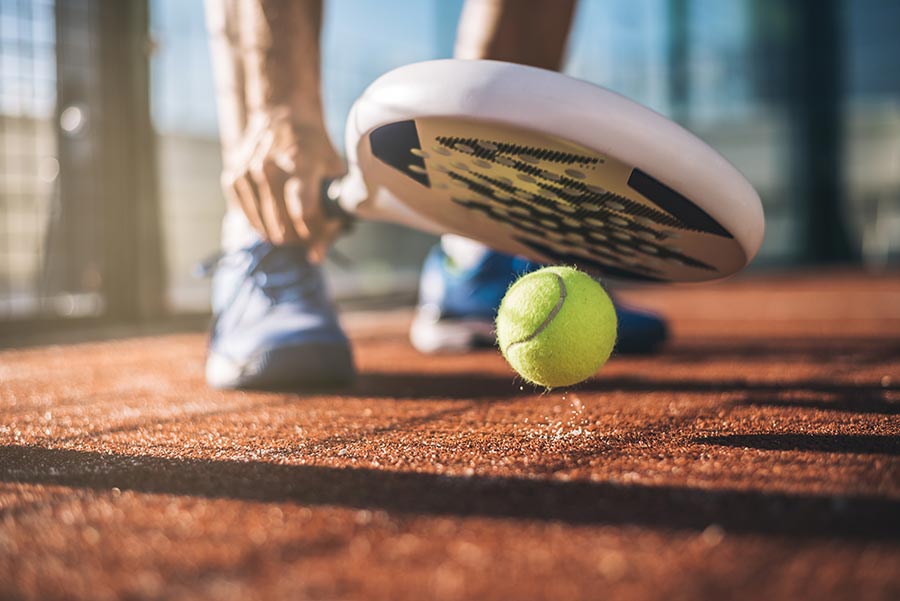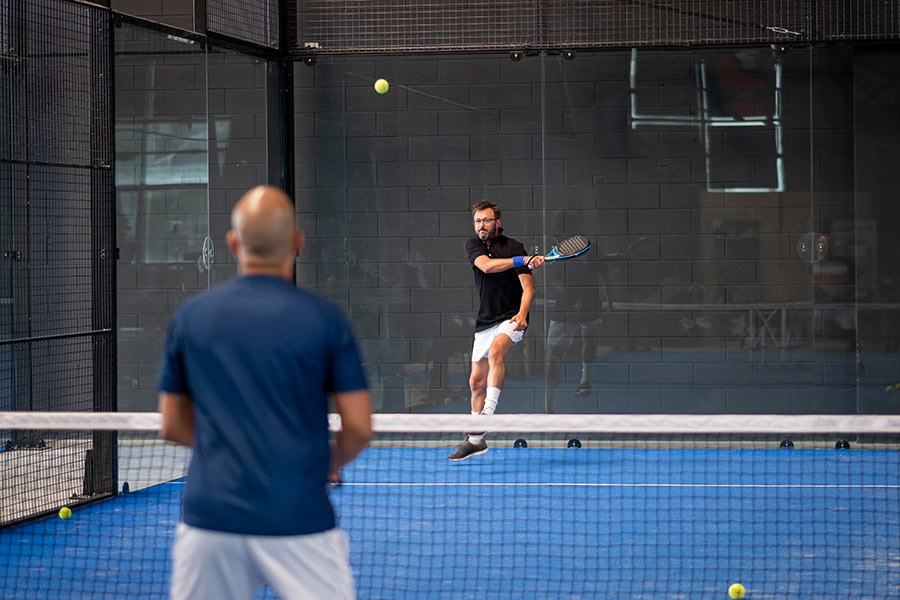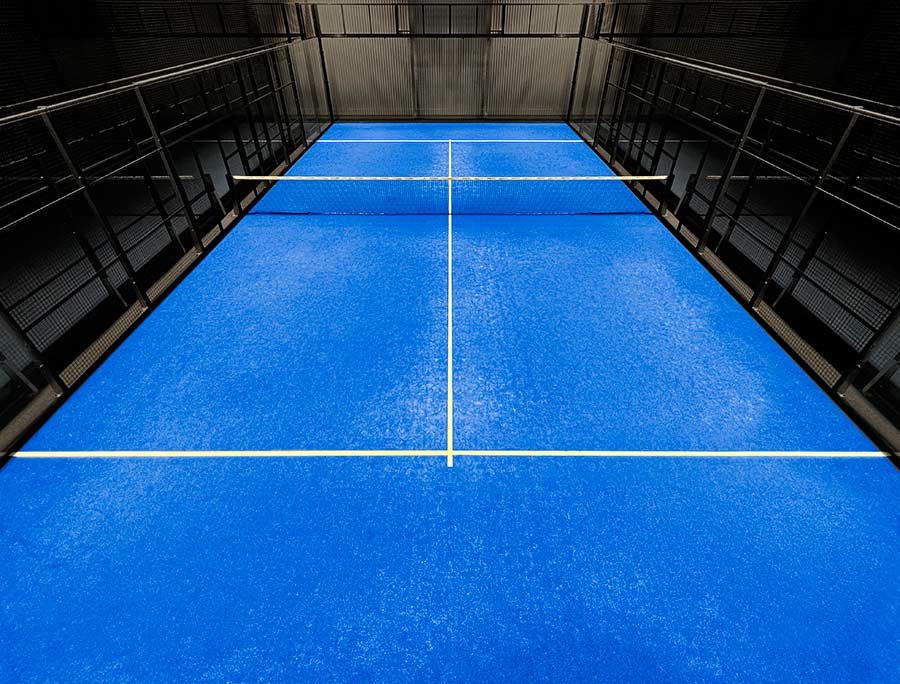With the arrival of warmer weather, many of us are looking for new ways to get outside, stay fit, and have fun. And though conventional activities like running and cycling are certainly good choices, why not consider a lesser-known activity like padel?
While many people in the UK may not have heard of it, padel is one of the fastest-growing sports in the world – and for good reason! It’s entertaining, sociable, and ideal for people of all ages.
If you’d like to learn more about this up-and-coming sport, take a look below where we explain what padel is, what the benefits are, and how you can get involved…
What is padel?

Padel (also known as padel-tennis), is a racket sport that’s very similar to tennis. However, it also incorporates some elements of squash: most notably, players are allowed to bounce the ball off the walls of the court.
Invented in the 1960s by Mexican businessman Enrique Corcuera, it’s played on a specifically-designed padel court, and usually in a doubles format (although you can play singles if you choose).
While it’s not as widespread in the UK as it is in other parts of the world at present, padel has been steadily growing in popularity in the last few decades – especially in Spain, Mexico, and South American countries – with over 25 million players worldwide. And there are more and more padel courts popping up across the UK by the month.
How do you play padel?

Padel is pretty easy to get to grips with. Below, we’ll talk about what the court is like and the rules…
The court

Before you start learning the rules, it’s helpful to get a basic understanding of what a padel court is like.
While a padel court may look similar to a tennis court, it’s different in a number of ways. For starters, it’s around 25% smaller; measuring 20m long by 10m wide. The net in the middle (at 88cm above the ground) is also a little shorter than the one you’d usually find on a tennis court.
The second big difference is that a padel court is completely enclosed by walls and fences, which split the court into sections. The walls are typically made of perspex and mark the ends of the court, while the sections of fence (usually made from wire mesh) are located in the middle and also line the top of the walls.
By the sides of the nets, there are also openings where players can run out of the court to chase the ball (more on this in the next section).
For a more detailed breakdown of a padel court, check out this data sheet from the Lawn Tennis Association (LTA).
The rules

Like tennis, the basic aim of padel is to play the ball over the net into the opponent’s side of the court. The opponent is then allowed a maximum of one bounce on the floor of the court before they’re required to return it.
Padel is also scored like tennis. Matches are made up of three or five sets which, in turn, are made up of games. The first player to win six games wins the set, and they must win by two clear games (however, if there’s a 6-6 draw, then a tie-break game is played). Individual games – again, like tennis – are scored using the 15, 30, 40, game system.
For more information on padel scoring, you can take a look at this article from Rookie Road.
While there are various similarities between the rules of tennis and padel, there are also plenty of differences. For example, in padel, you can…
- Bounce the ball off the walls and fences of the court – Though, the rules are different depending on the situation…
For example, if you’re playing the ball over the net and into your opponent’s side of the court, it must bounce on the floor of their side of the court first before hitting the wall or fence. If you hit their side of the wall or fence before it bounces, then it’s considered a fault and you lose a point.
On the serve, if the ball hits your opponent’s fence, even after a bounce, then it’s considered a fault. It can, however, hit the wall, as long as it bounces in their service box first.
You can also bounce the ball off the wall on your own side of the court, as long as it then lands on the opponent’s side of the court. But you cannot bounce the ball off the fence on your side of the court.
- You must serve underarm – Serves must be taken from behind the service line (which is the horizontal line on each side of the court that runs parallel to the net).
Each time you serve, you must bounce the ball once behind this line and strike it at waist height or below – making sure that at least one foot remains on the ground.
- You can play the ball back in from outside the court – If an opponent plays the ball into your side of the court and it bounces out (either via the wall or not), you’re allowed to leave the court and try to play the ball back into their side.
While these are some of the biggest rules of padel, there are a handful more that you’ll need to familiarise yourself with before stepping onto the court. And while they may seem a little difficult to get your head around at first, as soon as you get out there and play a little, they’ll sink in pretty fast.
For a more comprehensive outline of the rules, check out this article from All For Padel, or watch the video below.
What are the benefits of playing padel?

From weight loss and improved brain health to stress reduction and the chance to meet new people – the benefits of playing any kind of sport are numerous.
However, padel comes with some bonuses that other sports might not offer. Some of the best are…
- Padel is easy to learn – Almost anyone can get to grips with the basics of padel within minutes, especially if you’ve got previous experience with other racket sports like tennis and pickleball.
- Padel can be enjoyed by people of all ages and abilities – A padel match can be played as leisurely or as intensely as you like.
- Padel is ideal to play intergenerationally – A game of padel isn’t as easily influenced by things like a player’s strength and speed. Instead, it places a higher value on tactics. This makes it an ideal sport for people of all ages to play against/with one another.
- Padel is relatively affordable – While you may need to rent a court to play padel, you can get your own racket and equipment relatively cheaply (more on this later).
- Padel can be played in all weather – You can find courts both inside and outside, so you can enjoy a game of padel no matter the weather or time of year.
- Padel improves balance – Physical therapist Dr Vijay A. Daryanani told Harvard Health that racket sports are particularly good for improving balance because they involve not only moving back and forth but also side to side.
- Padel can lower our risk of death from heart disease – While all cardiovascular exercise can help with this, a study from the National Institutes of Health (NIH) found that racket sports do this best.
- Padel is fun! – There’s a reason why 25 million people around the world (and counting) have taken up padel!
Because of the small size of the court and the fact that you can use the walls, among other things, rallies can last a lot longer in padel than other sports (Everything Padel estimates 60-70% longer than tennis), which can make games really exciting.
Check out the video below to get a taste of how exciting a padel rally can be…
What equipment do I need to play padel?

Other than the court itself (which we’ll talk about in the next section), all you need to get started with padel is a racket and ball…
Racket
Unlike tennis rackets, padel rackets don’t have strings. Instead, they’re made of a solid outer layer (which is usually something like carbon fibre or fibreglass) and a foam interior.
Nowadays, there are lots of different padel rackets on the market, each suited to a different ability level or style of play.
For example, rackets that are round in shape are more suited to beginners than diamond-shaped ones, because they’re easier to handle and a little more forgiving when it comes to controlling the ball.
Newbies might also prefer to play with a light, soft racket that’s round in shape and has a low balance. These types of rackets are generally easier to play with, will allow you to focus on developing your technique, and can even help to prevent injury.
Decathlon has a great selection of padel rackets at good prices. Or, to find out more about the best ones on the market right now, take a look at this article from Simple Padel.
And to learn more about how to choose the best padel racket for you, why not check out this post from Padel Joy?
Balls
Padel balls look a lot like tennis balls – and for the most part, they’re pretty much the same. However, there are a couple of key differences.
Padel balls have a slightly lower internal pressure than tennis balls (around 11psi versus 14psi), which makes them a little less bouncy.
They’re also slightly smaller, which suits the smaller court. So while you could use a tennis ball in a game of padel, you’d be better off using one that’s designed specifically for the sport.
Amazon and Decathlon both have good selections of padel balls at decent prices.
What should I wear?
There’s no specific dress code when playing padel, so you can wear whatever makes you most comfortable. Many padel players would recommend wearing light, soft, and breathable sportswear with a pair of supportive trainers.
If you start playing padel regularly, you could even consider investing in a pair of padel shoes further down the line. These are specifically designed to offer maximum comfort, grip, and cushioning – to improve your performance and protect you from injury.
Decathlon has a wide range of padel shoes at various price points.
How to get started with padel

If you’re interested in trying padel, there are a few ways you can get stuck in…
Book a padel court and play
As we’ve already mentioned, padel is an easy game to pick up – so once you’ve got a basic understanding of the rules and the right equipment, you can round up some of your friends/family and find a padel court.
You can use the LTA’s handy search engine below to find padel courts near you. And for some handy tips to get you ready for your first game, check out this post from Everything Padel.
Note: Unfortunately, at present, there are only around 250 places with padel courts in the UK, with the bulk of them being located in England. So, depending on where you live, it might be difficult to find a court.
However, as one of the country’s fastest-growing sports, more and more padel courts are being opened by the month.
Join a padel club
If you live near a padel club, you could consider signing up to become a member. While club memberships differ, they can include things like lessons from seasoned coaches, access to matches and tournaments, and discounts on padel equipment.
Although, most importantly, by becoming a member of a padel club, you’ll be able to meet other padel lovers on the court and through organised events like socials.
Sign-up for social padel sessions
If you’re looking to meet fellow padel players and boost your skills on the court, then social padel sessions could be worth looking into.
While this isn’t available at all padel facilities, social padel coaching – like these offered by the National Tennis Centre in Roehampton – typically involves playing short matches against other padel lovers. Some even offer advice from a qualified coach as well.
Final thoughts…
And there we have it! If you’re interested in getting stuck into a new hobby that’s as good for you as it is addictive, why not try padel?
For more sports and activities inspiration, check out the hobbies and fitness sections of our website, where you’ll find introductory guides to everything from surfing to walking football.
* Links with an * by them are affiliate links which help Rest Less stay free to use as they can result in a payment or benefit to us. You can read more on how we make money here.

Free NHS eye tests plus 10% off glasses for over 60s
Booking an appointment online has never been easier, and with a range of offers from 10% off if you’re over 60, 2nd pairs half price & a free NHS eye test if eligible, our expert optometrists are here to help you on your journey to clearer vision.
